 Spring6 - AOP
Spring6 - AOP
# 场景模拟
搭建子模块:Spring6-aop
# 声明接口
声明计算器接口 Calculator,包含加减乘除的抽象方法
public interface Calculator {
int add(int i, int j);
int sub(int i, int j);
int mul(int i, int j);
int div(int i, int j);
}
2
3
4
5
6
7
8
9
10
11
# 创建实现类

public class CalculatorImpl implements Calculator {
@Override
public int add(int i, int j) {
int result = i + j;
System.out.println("方法内部 result = " + result);
return result;
}
@Override
public int sub(int i, int j) {
int result = i - j;
System.out.println("方法内部 result = " + result);
return result;
}
@Override
public int mul(int i, int j) {
int result = i * j;
System.out.println("方法内部 result = " + result);
return result;
}
@Override
public int div(int i, int j) {
int result = i / j;
System.out.println("方法内部 result = " + result);
return result;
}
}
2
3
4
5
6
7
8
9
10
11
12
13
14
15
16
17
18
19
20
21
22
23
24
25
26
27
28
29
30
31
32
33
34
35
36
37
38
39
40
41
42
# 创建带日志功能的实现类
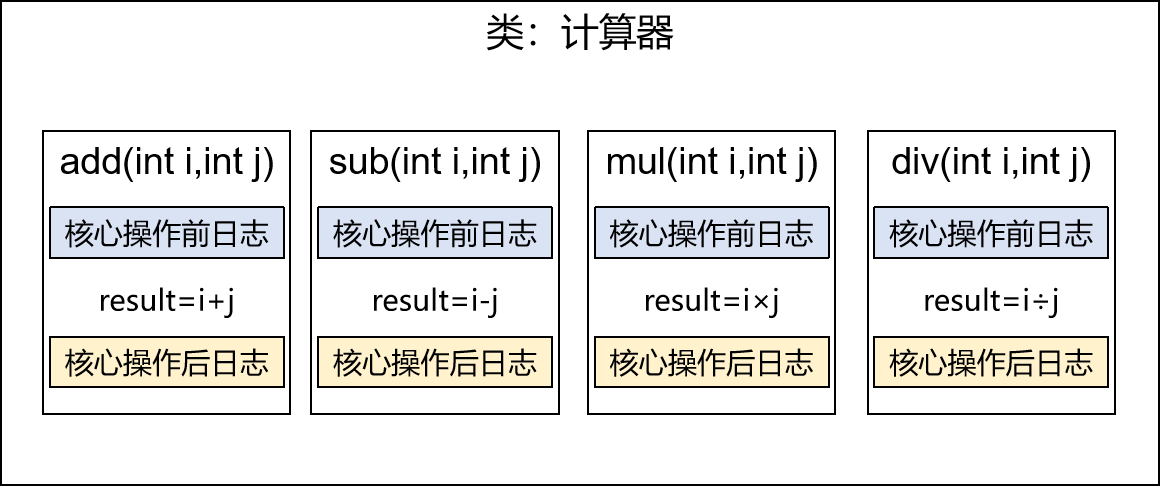
public class CalculatorLogImpl implements Calculator {
@Override
public int add(int i, int j) {
System.out.println("[日志] add 方法开始了,参数是:" + i + "," + j);
int result = i + j;
System.out.println("方法内部 result = " + result);
System.out.println("[日志] add 方法结束了,结果是:" + result);
return result;
}
@Override
public int sub(int i, int j) {
System.out.println("[日志] sub 方法开始了,参数是:" + i + "," + j);
int result = i - j;
System.out.println("方法内部 result = " + result);
System.out.println("[日志] sub 方法结束了,结果是:" + result);
return result;
}
@Override
public int mul(int i, int j) {
System.out.println("[日志] mul 方法开始了,参数是:" + i + "," + j);
int result = i * j;
System.out.println("方法内部 result = " + result);
System.out.println("[日志] mul 方法结束了,结果是:" + result);
return result;
}
@Override
public int div(int i, int j) {
System.out.println("[日志] div 方法开始了,参数是:" + i + "," + j);
int result = i / j;
System.out.println("方法内部 result = " + result);
System.out.println("[日志] div 方法结束了,结果是:" + result);
return result;
}
}
2
3
4
5
6
7
8
9
10
11
12
13
14
15
16
17
18
19
20
21
22
23
24
25
26
27
28
29
30
31
32
33
34
35
36
37
38
39
40
41
42
43
44
45
46
47
48
49
50
51
52
53
54
55
56
57
58
# 提出问题
针对带日志功能的实现类,我们发现有如下缺陷:
- 对核心业务功能有干扰,导致程序员在开发核心业务功能时分散了精力
- 附加功能分散在各个业务功能方法中,不利于统一维护
解决思路
解决这两个问题,核心就是:解耦。我们需要把附加功能从业务功能代码中抽取出来。
困难
解决问题的困难:要抽取的代码在方法内部,靠以前把子类中的重复代码抽取到父类的方式没法解决。所以需要引入新的技术。
# 代理模式
# 概念
介绍
二十三种设计模式中的一种,属于结构型模式。它的作用就是通过提供一个代理类,让我们在调用目标方法的时候,不再是直接对目标方法进行调用,而是通过代理类 间接 调用。让不属于目标方法核心逻辑的代码从目标方法中剥离出来—— 解耦。调用目标方法时先调用代理对象的方法,减少对目标方法的调用和打扰,同时让附加功能能够集中在一起也有利于统一维护。

使用代理后:

生活中的代理
- 广告商找大明星拍广告需要经过经纪人
- 合作伙伴找大老板谈合作要约见面时间需要经过秘书
- 房产中介是买卖双方的代理
相关术语
- 代理:将非核心逻辑剥离出来以后,封装这些非核心逻辑的类、对象、方法。
- 目标:被代理「套用」了非核心逻辑代码的类、对象、方法。
# 静态代理
创建静态代理类:
public class CalculatorStaticProxy implements Calculator {
// 将被代理的目标对象声明为成员变量
private Calculator target;
public CalculatorStaticProxy(Calculator target) {
this.target = target;
}
@Override
public int add(int i, int j) {
// 附加功能由代理类中的代理方法来实现
System.out.println("[日志] add 方法开始了,参数是:" + i + "," + j);
// 通过目标对象来实现核心业务逻辑
int addResult = target.add(i, j);
System.out.println("[日志] add 方法结束了,结果是:" + addResult);
return addResult;
}
}
2
3
4
5
6
7
8
9
10
11
12
13
14
15
16
17
18
19
20
21
22
23
静态代理确实实现了解耦,但是由于代码都写死了,完全不具备任何的灵活性。就拿日志功能来说,将来其他地方也需要附加日志,那还得再声明更多个静态代理类,那就产生了大量重复的代码,日志功能还是分散的,没有统一管理。
提出进一步的需求:将日志功能集中到一个代理类中,将来有任何日志需求,都通过这一个代理类来实现。这就需要使用动态代理技术了。
# 动态代理
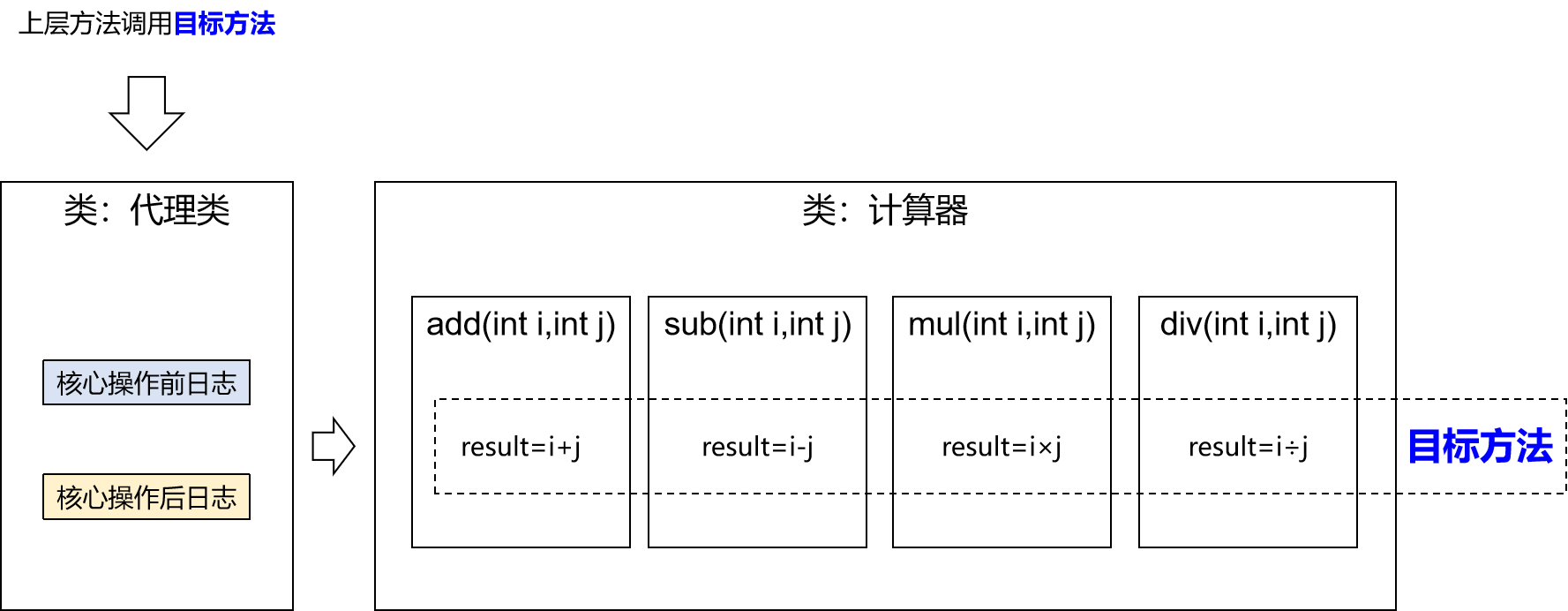
生产代理对象的工厂类:
public class ProxyFactory {
private Object target;
public ProxyFactory(Object target) {
this.target = target;
}
public Object getProxy(){
/**
* newProxyInstance():创建一个代理实例
* 其中有三个参数:
* 1、classLoader:加载动态生成的代理类的类加载器
* 2、interfaces:目标对象实现的所有接口的class对象所组成的数组
* 3、invocationHandler:设置代理对象实现目标对象方法的过程,即代理类中如何重写接口中的抽象方法
*/
ClassLoader classLoader = target.getClass().getClassLoader();
Class<?>[] interfaces = target.getClass().getInterfaces();
InvocationHandler invocationHandler = new InvocationHandler() {
@Override
public Object invoke(Object proxy, Method method, Object[] args) throws Throwable {
/**
* proxy:代理对象
* method:代理对象需要实现的方法,即其中需要重写的方法
* args:method所对应方法的参数
*/
Object result = null;
try {
System.out.println("[动态代理][日志] "+method.getName()+",参数:"+ Arrays.toString(args));
result = method.invoke(target, args);
System.out.println("[动态代理][日志] "+method.getName()+",结果:"+ result);
} catch (Exception e) {
e.printStackTrace();
System.out.println("[动态代理][日志] "+method.getName()+",异常:"+e.getMessage());
} finally {
System.out.println("[动态代理][日志] "+method.getName()+",方法执行完毕");
}
return result;
}
};
return Proxy.newProxyInstance(classLoader, interfaces, invocationHandler);
}
}
2
3
4
5
6
7
8
9
10
11
12
13
14
15
16
17
18
19
20
21
22
23
24
25
26
27
28
29
30
31
32
33
34
35
36
37
38
39
40
41
42
43
44
45
# 测试
@Test
public void testDynamicProxy(){
ProxyFactory factory = new ProxyFactory(new CalculatorLogImpl());
Calculator proxy = (Calculator) factory.getProxy();
proxy.div(1,0);
//proxy.div(1,1);
}
2
3
4
5
6
7
# AOP 概念及相关术语
# 概述
AOP(Aspect Oriented Programming)是一种设计思想,是软件设计领域中的面向切面编程,它是面向对象编程的一种补充和完善,它以通过预编译方式和运行期动态代理方式实现,在不修改源代码的情况下,给程序动态统一添加额外功能的一种技术。利用 AOP 可以对业务逻辑的各个部分进行隔离,从而使得业务逻辑各部分之间的耦合度降低,提高程序的可重用性,同时提高了开发的效率。
# 相关术语
# 横切关注点
分散在每个各个模块中解决同一样的问题,如用户验证、日志管理、事务处理、数据缓存都属于横切关注点。
从每个方法中抽取出来的同一类非核心业务。在同一个项目中,我们可以使用多个横切关注点对相关方法进行多个不同方面的增强。
这个概念不是语法层面的,而是根据附加功能的逻辑上的需要:有十个附加功能,就有十个横切关注点。
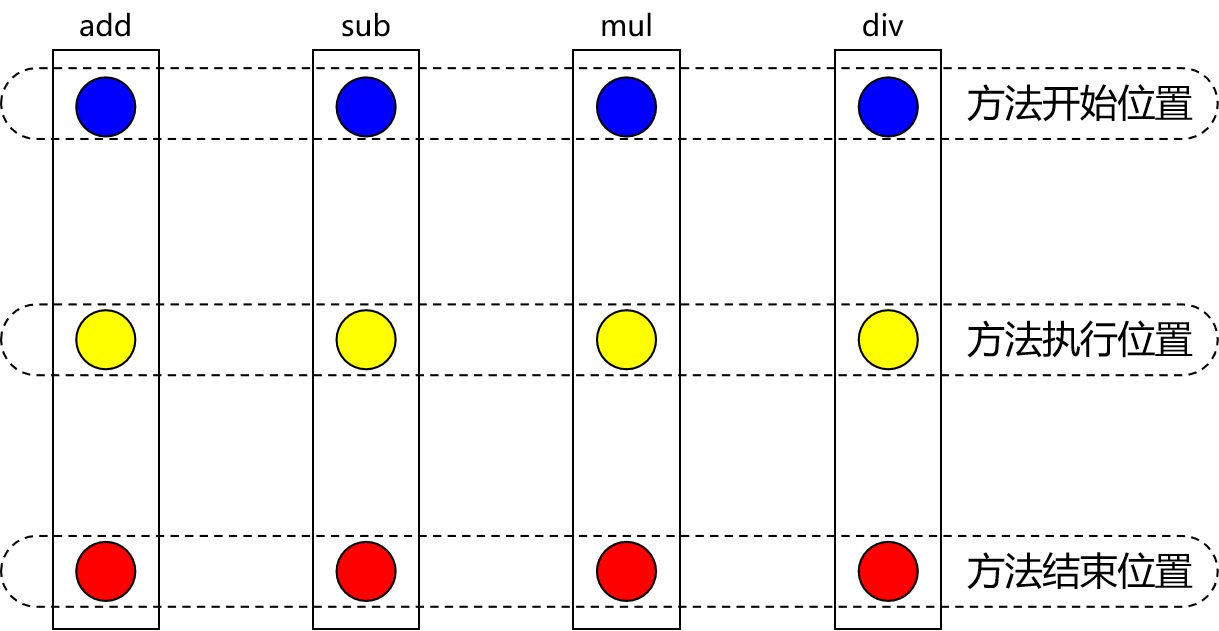
# ②通知(增强)
增强,通俗说,就是你想要增强的功能,比如 安全,事务,日志等。
每一个横切关注点上要做的事情都需要写一个方法来实现,这样的方法就叫通知方法。
- 前置通知:在被代理的目标方法前执行
- 返回通知:在被代理的目标方法成功结束后执行(寿终正寝)
- 异常通知:在被代理的目标方法异常结束后执行(死于非命)
- 后置通知:在被代理的目标方法最终结束后执行(盖棺定论)
- 环绕通知:使用try...catch...finally结构围绕整个被代理的目标方法,包括上面四种通知对应的所有位置
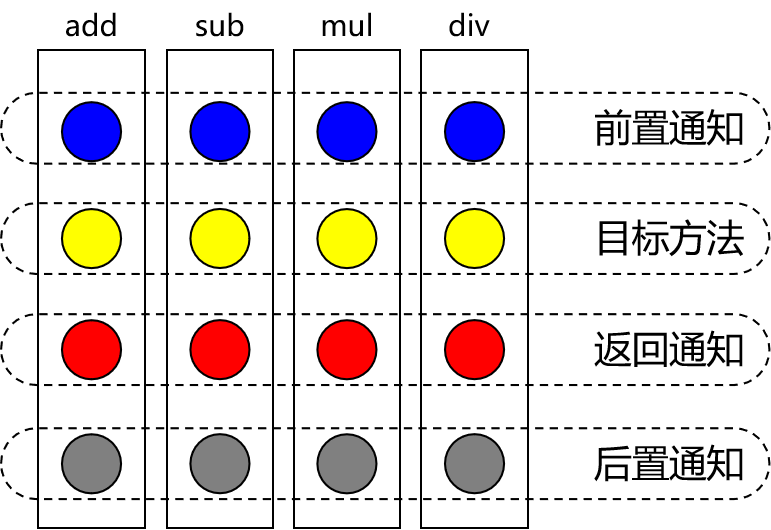
# 切面
封装通知方法的类。
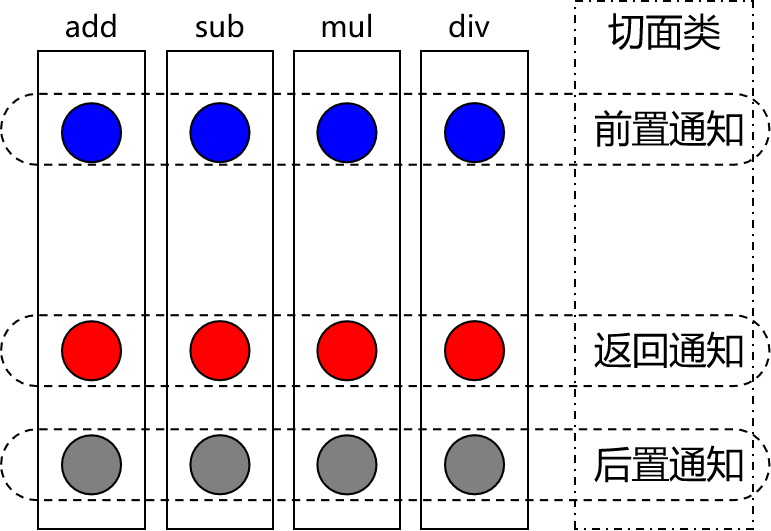
# 目标
被代理的目标对象。
# 代理
向目标对象应用通知之后创建的代理对象。
# 连接点
这也是一个纯逻辑概念,不是语法定义的。
把方法排成一排,每一个横切位置看成 x 轴方向,把方法从上到下执行的顺序看成y轴,x 轴和 y 轴的交叉点就是连接点。通俗说,就是 Spring 允许你使用通知的地方。
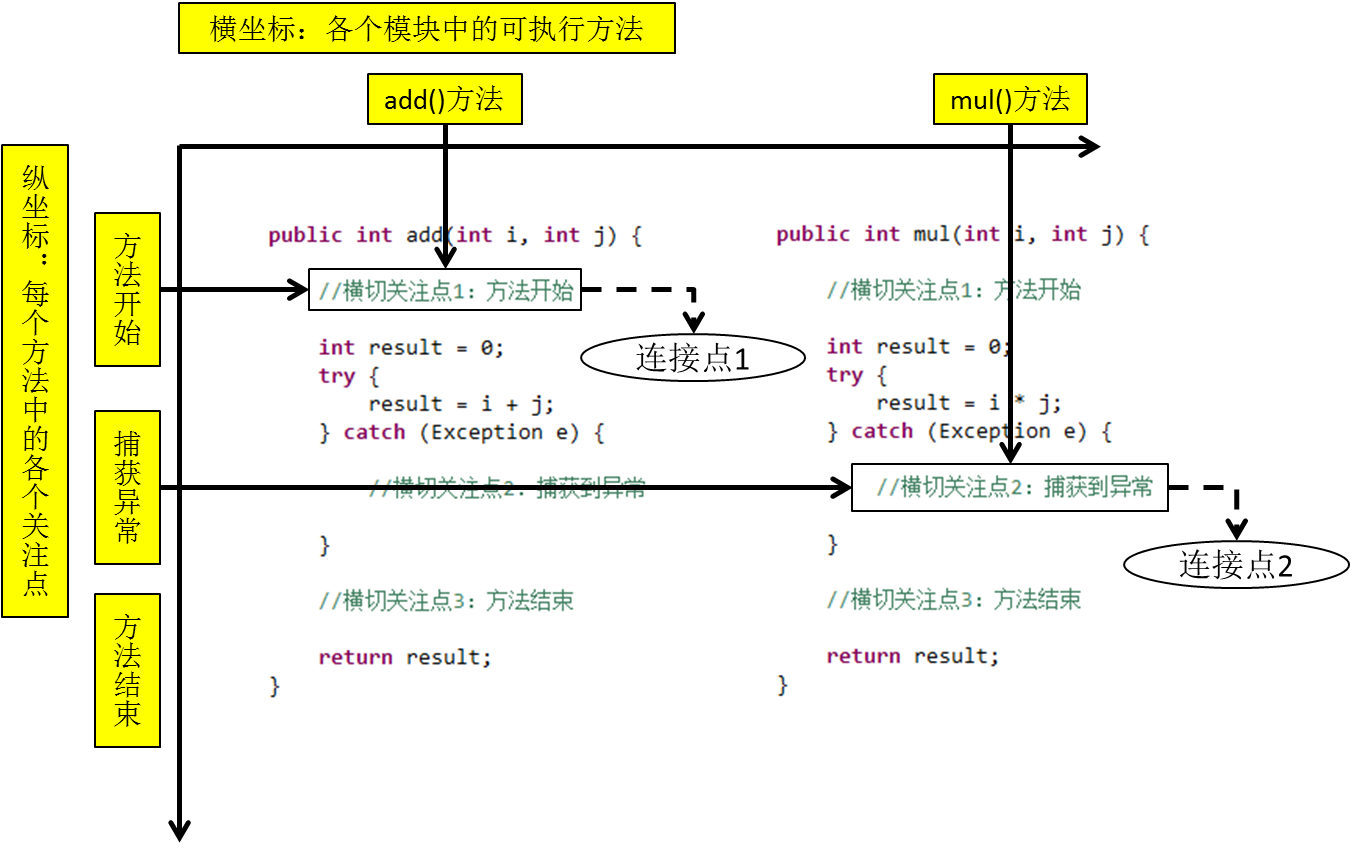
# 切入点
定位连接点的方式。
每个类的方法中都包含多个连接点,所以连接点是类中客观存在的事物(从逻辑上来说)。
如果把连接点看作数据库中的记录,那么切入点就是查询记录的 SQL 语句。
Spring 的 AOP 技术可以通过切入点定位到特定的连接点。通俗说,要实际去增强的方法
切点通过 org.Springframework.aop.Pointcut 接口进行描述,它使用类和方法作为连接点的查询条件。
# 作用
简化代码:把方法中固定位置的重复的代码 抽取 出来,让被抽取的方法更专注于自己的核心功能,提高内聚性
代码增强:把特定的功能封装到切面类中,看哪里有需要,就往上套,被 套用 了切面逻辑的方法就被切面给增强了
# 基于注解的 AOP
# 技术说明

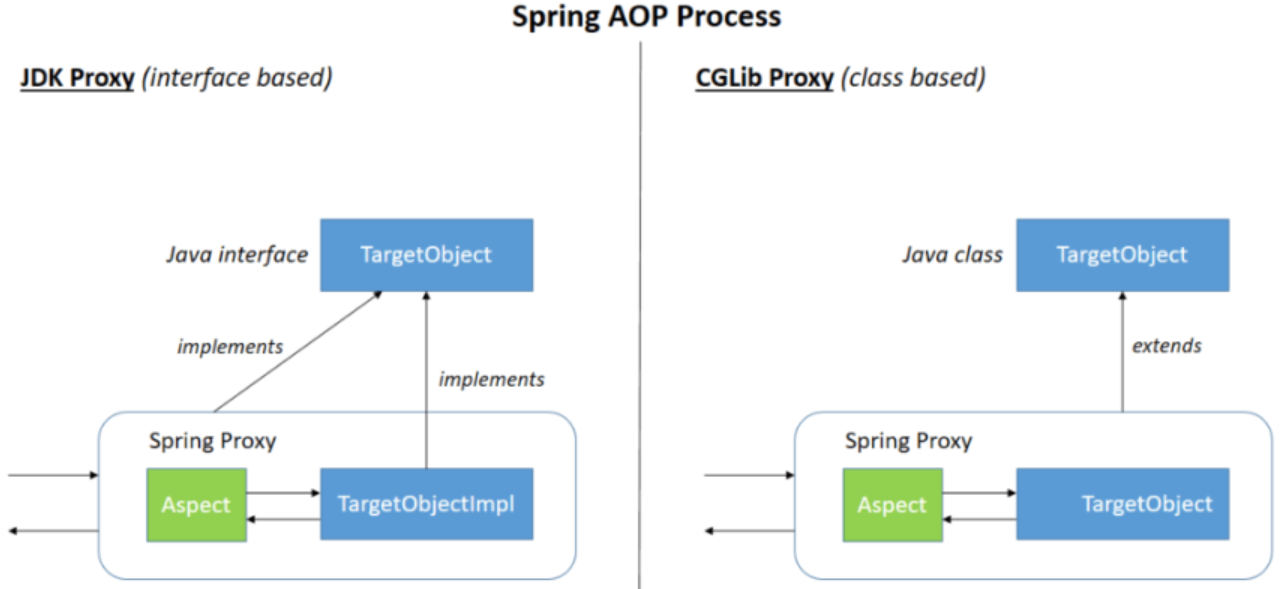
- 动态代理分为 JDK 动态代理和 cglib 动态代理
- 当目标类有接口的情况使用 JDK 动态代理和 cglib 动态代理,没有接口时只能使用 cglib 动态代理
- JDK 动态代理动态生成的代理类会在
com.sun.proxy包下,类名为$proxy1,和目标类实现相同的接口 - cglib 动态代理动态生成的代理类会和目标在在相同的包下,会继承目标类
- 动态代理(InvocationHandler):JDK 原生的实现方式,需要被代理的目标类必须实现接口。因为这个技术要求 代理对象和目标对象实现同样的接口(兄弟两个拜把子模式)
- cglib:通过 继承被代理的目标类(认干爹模式)实现代理,所以不需要目标类实现接口
- AspectJ:是 AOP 思想的一种实现。本质上是静态代理,将代理逻辑「织入」被代理的目标类编译得到的字节码文件,所以最终效果是动态的。weaver 就是织入器。Spring 只是借用了 AspectJ 中的注解
# 准备工作
在 XML 所需依赖基础上再加入下面依赖即可:
<dependencies>
<!--Spring context 依赖-->
<!--当引入 Spring Context 依赖之后,表示将 Spring 的基础依赖引入了-->
<dependency>
<groupId>org.Springframework</groupId>
<artifactId>Spring-context</artifactId>
<version>6.0.2</version>
</dependency>
<!--Spring aop 依赖-->
<dependency>
<groupId>org.Springframework</groupId>
<artifactId>Spring-aop</artifactId>
<version>6.0.2</version>
</dependency>
<!--Spring aspects 依赖-->
<dependency>
<groupId>org.Springframework</groupId>
<artifactId>Spring-aspects</artifactId>
<version>6.0.2</version>
</dependency>
<!--junit5 测试-->
<dependency>
<groupId>org.junit.jupiter</groupId>
<artifactId>junit-jupiter-api</artifactId>
<version>5.3.1</version>
</dependency>
<!--log4j2 的依赖-->
<dependency>
<groupId>org.apache.logging.log4j</groupId>
<artifactId>log4j-core</artifactId>
<version>2.19.0</version>
</dependency>
<dependency>
<groupId>org.apache.logging.log4j</groupId>
<artifactId>log4j-slf4j2-impl</artifactId>
<version>2.19.0</version>
</dependency>
</dependencies>
2
3
4
5
6
7
8
9
10
11
12
13
14
15
16
17
18
19
20
21
22
23
24
25
26
27
28
29
30
31
32
33
34
35
36
37
38
39
40
41
准备被代理的目标资源
接口:
public interface Calculator {
int add(int i, int j);
int sub(int i, int j);
int mul(int i, int j);
int div(int i, int j);
}
2
3
4
5
6
7
8
9
10
11
实现类:
@Component
public class CalculatorImpl implements Calculator {
@Override
public int add(int i, int j) {
int result = i + j;
System.out.println("方法内部 result = " + result);
return result;
}
@Override
public int sub(int i, int j) {
int result = i - j;
System.out.println("方法内部 result = " + result);
return result;
}
@Override
public int mul(int i, int j) {
int result = i * j;
System.out.println("方法内部 result = " + result);
return result;
}
@Override
public int div(int i, int j) {
int result = i / j;
System.out.println("方法内部 result = " + result);
return result;
}
}
2
3
4
5
6
7
8
9
10
11
12
13
14
15
16
17
18
19
20
21
22
23
24
25
26
27
28
29
30
31
32
33
34
35
36
37
38
39
40
41
42
43
# 创建切面类并配置
// @Aspect 表示这个类是一个切面类
@Aspect
// @Component 注解保证这个切面类能够放入 IOC 容器
@Component
public class LogAspect {
@Before("execution(public int cn.youngkbt.aop.annotation.CalculatorImpl.*(..))")
public void beforeMethod(JoinPoint joinPoint){
String methodName = joinPoint.getSignature().getName();
String args = Arrays.toString(joinPoint.getArgs());
System.out.println("Logger-->前置通知,方法名:"+methodName+",参数:"+args);
}
@After("execution(* cn.youngkbt.aop.annotation.CalculatorImpl.*(..))")
public void afterMethod(JoinPoint joinPoint){
String methodName = joinPoint.getSignature().getName();
System.out.println("Logger-->后置通知,方法名:"+methodName);
}
@AfterReturning(value = "execution(* cn.youngkbt.aop.annotation.CalculatorImpl.*(..))", returning = "result")
public void afterReturningMethod(JoinPoint joinPoint, Object result){
String methodName = joinPoint.getSignature().getName();
System.out.println("Logger-->返回通知,方法名:"+methodName+",结果:"+result);
}
@AfterThrowing(value = "execution(* cn.youngkbt.aop.annotation.CalculatorImpl.*(..))", throwing = "ex")
public void afterThrowingMethod(JoinPoint joinPoint, Throwable ex){
String methodName = joinPoint.getSignature().getName();
System.out.println("Logger-->异常通知,方法名:"+methodName+",异常:"+ex);
}
@Around("execution(* cn.youngkbt.aop.annotation.CalculatorImpl.*(..))")
public Object aroundMethod(ProceedingJoinPoint joinPoint){
String methodName = joinPoint.getSignature().getName();
String args = Arrays.toString(joinPoint.getArgs());
Object result = null;
try {
System.out.println("环绕通知-->目标对象方法执行之前");
//目标对象(连接点)方法的执行
result = joinPoint.proceed();
System.out.println("环绕通知-->目标对象方法返回值之后");
} catch (Throwable throwable) {
throwable.printStackTrace();
System.out.println("环绕通知-->目标对象方法出现异常时");
} finally {
System.out.println("环绕通知-->目标对象方法执行完毕");
}
return result;
}
}
2
3
4
5
6
7
8
9
10
11
12
13
14
15
16
17
18
19
20
21
22
23
24
25
26
27
28
29
30
31
32
33
34
35
36
37
38
39
40
41
42
43
44
45
46
47
48
49
50
51
在Spring的配置文件中配置:
<?xml version="1.0" encoding="UTF-8"?>
<Beans xmlns="http://www.Springframework.org/schema/Beans"
xmlns:xsi="http://www.w3.org/2001/XMLSchema-instance"
xmlns:context="http://www.Springframework.org/schema/context"
xmlns:aop="http://www.Springframework.org/schema/aop"
xsi:schemaLocation="http://www.Springframework.org/schema/Beans
http://www.Springframework.org/schema/Beans/Spring-Beans.xsd
http://www.Springframework.org/schema/context
http://www.Springframework.org/schema/context/Spring-context.xsd
http://www.Springframework.org/schema/aop
http://www.Springframework.org/schema/aop/Spring-aop.xsd">
<!--
基于注解的 AOP 的实现:
1、将目标对象和切面交给 XML 容器管理(注解 + 扫描)
2、开启 AspectJ 的自动代理,为目标对象自动生成代理
3、将切面类通过注解 @Aspect 标识
-->
<context:component-scan base-package="cn.youngkbt.aop.annotation"></context:component-scan>
<aop:aspectj-autoproxy />
</Beans>
2
3
4
5
6
7
8
9
10
11
12
13
14
15
16
17
18
19
20
21
执行测试:
public class CalculatorTest {
private Logger logger = LoggerFactory.getLogger(CalculatorTest.class);
@Test
public void testAdd(){
ApplicationContext ac = new ClassPathXmlApplicationContext("Beans.xml");
Calculator calculator = ac.getBean( Calculator.class);
int add = calculator.add(1, 1);
logger.info("执行成功:"+add);
}
}
2
3
4
5
6
7
8
9
10
11
12
13
执行结果:

# 各种通知
- 前置通知:使用
@Before注解标识,在被代理的目标方法 前 执行 - 返回通知:使用
@AfterReturning注解标识,在被代理的目标方法 成功结束 后执行(寿终正寝) - 异常通知:使用
@AfterThrowing注解标识,在被代理的目标方法 异常结束 后执行(死于非命) - 后置通知:使用
@After注解标识,在被代理的目标方法 最终结束 后执行(盖棺定论) - 环绕通知:使用
@Around注解标识,使用try...catch...finally结构围绕 整个 被代理的目标方法,包括上面四种通知对应的所有位置
各种通知的执行顺序:
- Spring 版本 5.3.x 以前:
- 前置通知
- 目标操作
- 后置通知
- 返回通知或异常通知
- Spring 版本 5.3.x 以后:
- 前置通知
- 目标操作
- 返回通知或异常通知
- 后置通知
# 切入点表达式语法
作用
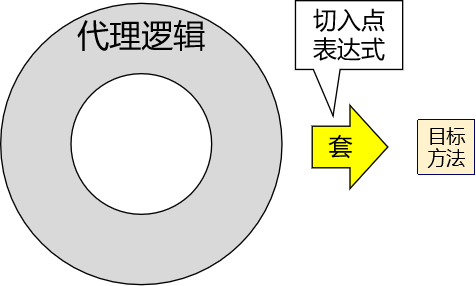
语法细节
用
*号代替「权限修饰符」和「返回值」部分表示「权限修饰符」和「返回值」不限在包名的部分,一个
*号只能代表包的层次结构中的一层,表示这一层是任意的- 例如:
*.Hello匹配com.Hello,不匹配cn.youngkbt.Hello
- 例如:
在包名的部分,使用「*..」表示包名任意、包的层次深度任意
在类名的部分,类名部分整体用
*号代替,表示类名任意在类名的部分,可以使用
*号代替类名的一部分- 例如:
*Service匹配所有名称以 Service 结尾的类或接口
- 例如:
在方法名部分,可以使用
*号表示方法名任意在方法名部分,可以使用
*号代替方法名的一部分- 例如:
*Operation匹配所有方法名以 Operation 结尾的方法
- 例如:
在方法参数列表部分,使用
(..)表示参数列表任意在方法参数列表部分,使用
(int,..)表示参数列表以一个 int 类型的参数开头在方法参数列表部分,基本数据类型和对应的包装类型是不一样的
- 切入点表达式中使用 int 和实际方法中 Integer 是不匹配的
在方法返回值部分,如果想要明确指定一个返回值类型,那么必须同时写明权限修饰符
- 例如:
execution(public int *..*Service.*(.., int))正确 例如:execution(* int *..*Service.*(.., int))错误
- 例如:

# 重用切入点表达式
声明
@Pointcut("execution(* cn.youngkbt.aop.annotation.*.*(..))")
public void pointCut(){}
2
在同一个切面中使用
@Before("pointCut()")
public void beforeMethod(JoinPoint joinPoint){
String methodName = joinPoint.getSignature().getName();
String args = Arrays.toString(joinPoint.getArgs());
System.out.println("Logger-->前置通知,方法名:"+methodName+",参数:"+args);
}
2
3
4
5
6
在不同切面中使用
@Before("cn.youngkbt.aop.CommonPointCut.pointCut()")
public void beforeMethod(JoinPoint joinPoint){
String methodName = joinPoint.getSignature().getName();
String args = Arrays.toString(joinPoint.getArgs());
System.out.println("Logger-->前置通知,方法名:"+methodName+",参数:"+args);
}
2
3
4
5
6
# 获取通知的相关信息
获取连接点信息
获取连接点信息可以在通知方法的参数位置设置 JoinPoint 类型的形参
@Before("execution(public int cn.youngkbt.aop.annotation.CalculatorImpl.*(..))")
public void beforeMethod(JoinPoint joinPoint){
//获取连接点的签名信息
String methodName = joinPoint.getSignature().getName();
//获取目标方法到的实参信息
String args = Arrays.toString(joinPoint.getArgs());
System.out.println("Logger-->前置通知,方法名:"+methodName+",参数:"+args);
}
2
3
4
5
6
7
8
获取目标方法的返回值
@AfterReturning 中的属性 returning,用来将通知方法的某个形参,接收目标方法的返回值
@AfterReturning(value = "execution(* cn.youngkbt.aop.annotation.CalculatorImpl.*(..))", returning = "result")
public void afterReturningMethod(JoinPoint joinPoint, Object result){
String methodName = joinPoint.getSignature().getName();
System.out.println("Logger-->返回通知,方法名:"+methodName+",结果:"+result);
}
2
3
4
5
获取目标方法的异常
@AfterThrowing 中的属性 throwing,用来将通知方法的某个形参,接收目标方法的异常
@AfterThrowing(value = "execution(* cn.youngkbt.aop.annotation.CalculatorImpl.*(..))", throwing = "ex")
public void afterThrowingMethod(JoinPoint joinPoint, Throwable ex){
String methodName = joinPoint.getSignature().getName();
System.out.println("Logger-->异常通知,方法名:"+methodName+",异常:"+ex);
}
2
3
4
5
# 环绕通知
@Around("execution(* cn.youngkbt.aop.annotation.CalculatorImpl.*(..))")
public Object aroundMethod(ProceedingJoinPoint joinPoint){
String methodName = joinPoint.getSignature().getName();
String args = Arrays.toString(joinPoint.getArgs());
Object result = null;
try {
System.out.println("环绕通知-->目标对象方法执行之前");
// 目标方法的执行,目标方法的返回值一定要返回给外界调用者
result = joinPoint.proceed();
System.out.println("环绕通知-->目标对象方法返回值之后");
} catch (Throwable throwable) {
throwable.printStackTrace();
System.out.println("环绕通知-->目标对象方法出现异常时");
} finally {
System.out.println("环绕通知-->目标对象方法执行完毕");
}
return result;
}
2
3
4
5
6
7
8
9
10
11
12
13
14
15
16
17
18
# 切面的优先级
相同目标方法上同时存在多个切面时,切面的优先级控制切面的 内外嵌套 顺序。
- 优先级高的切面:外面
- 优先级低的切面:里面
使用 @Order 注解可以控制切面的优先级:
@Order(较小的数):优先级高@Order(较大的数):优先级低

# 基于XML的AOP
# 准备工作
参考基于注解的 AOP 环境
# 实现
<context:component-scan base-package="cn.youngkbt.aop.xml"></context:component-scan>
<aop:config>
<!-- 配置切面类 -->
<aop:aspect ref="loggerAspect">
<aop:pointcut id="pointCut"
expression="execution(* cn.youngkbt.aop.xml.CalculatorImpl.*(..))"/>
<aop:before method="beforeMethod" pointcut-ref="pointCut"></aop:before>
<aop:after method="afterMethod" pointcut-ref="pointCut"></aop:after>
<aop:after-returning method="afterReturningMethod" returning="result" pointcut-ref="pointCut"></aop:after-returning>
<aop:after-throwing method="afterThrowingMethod" throwing="ex" pointcut-ref="pointCut"></aop:after-throwing>
<aop:around method="aroundMethod" pointcut-ref="pointCut"></aop:around>
</aop:aspect>
</aop:config>
2
3
4
5
6
7
8
9
10
11
12
13
14
